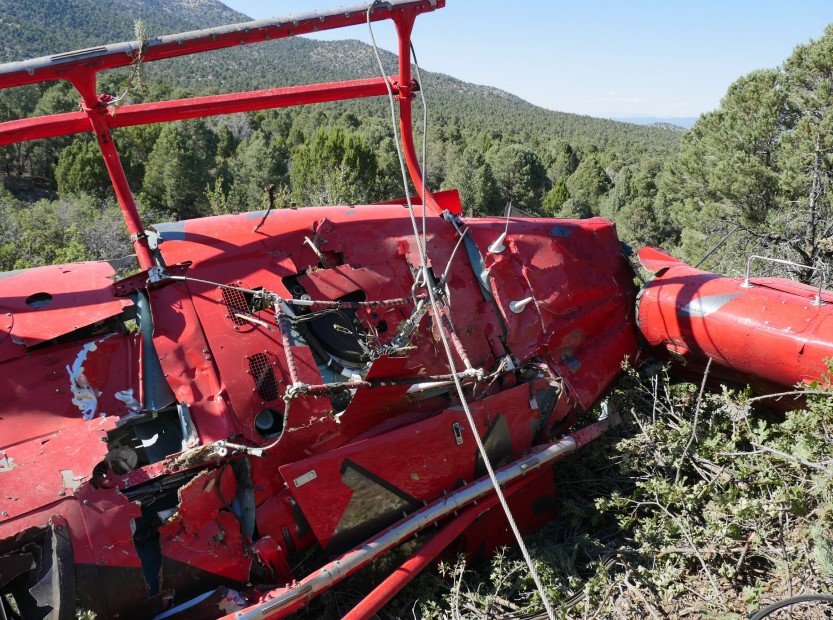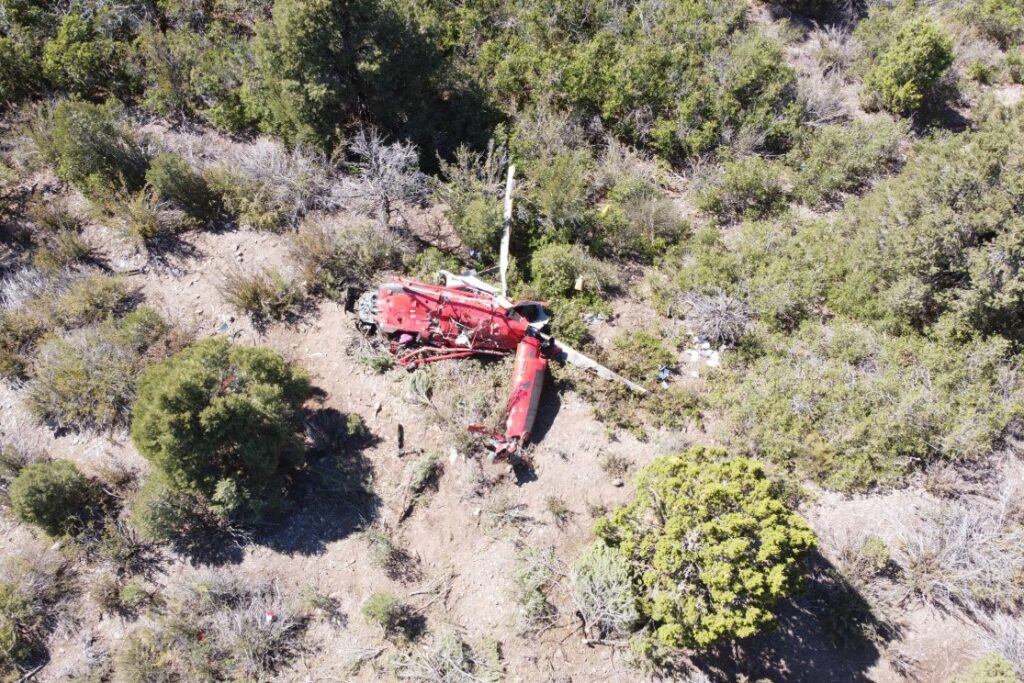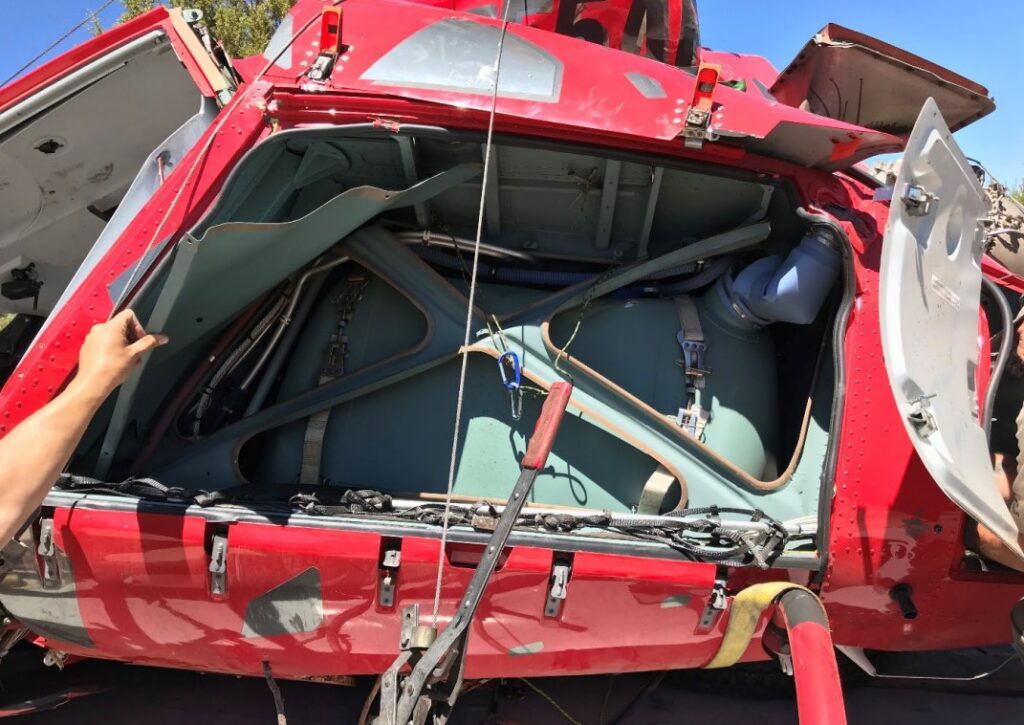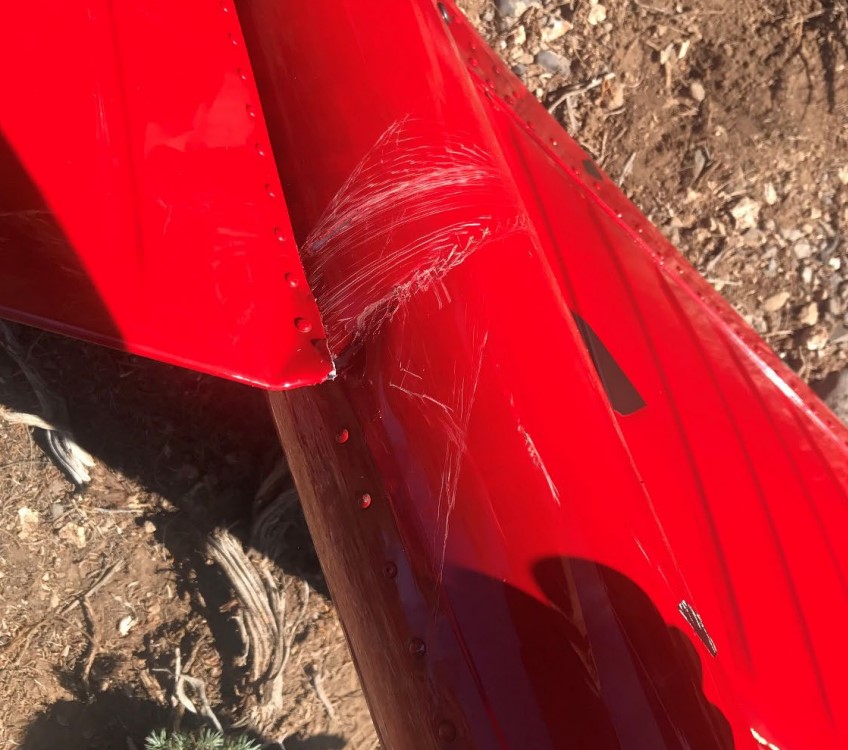HESLO H125 / AS350B3e N755AE Fatal Accident Positioning with an Unloaded Long Line
On 29 July 2020, Airbus Helicopters H125 / AS350B3e N755AE of St Louis Helicopter was destroyed, and the two occupants killed, in an accident near Pioche, Nevada.

Wreckage of St Louis Helicopter Airbus H125 / AS350B3e N755AE (Credit: FAA)
According to the US National Transportation Safety Board (NTSB) safety investigation report (issued 16 March 2023) the helicopter had landed on a mountain ridge (at an elevation of c 6,741 ft AMSL) during a survey prior to Helicopter External Sling Load Operations (HESLO) schedule for that day to move equipment to a mobile phone cell tower site. The accident flight was to be a c3 minute flight down from the ridge to a fuel truck to refuel (the fuel truck had been unable to drive any closer to the work site). On board were the pilot (owner of the company and who had 12,500 hours of total flight time) and a passenger.
A witness reported that…a cable that was laid out on the ground in front of the helicopter. The pilot stated to him that the cable was 70 feet long. The witness left the pilot and passenger at the helicopter and drove away; shortly thereafter, he received a phone call about smoke in the vicinity and learned that the helicopter had crashed.
The helicopter came to rest on its right side in heavily wooded terrain c 630 m from the fuel truck..

Wreckage of St Louis Helicopter Airbus H125 / AS350B3e N755AE (Credit: FAA)
The aircraft was equipped with a Crash Resistant Fuel System (CRFS). This suffered some impact damage, but there was no evidence of any fuel loss.

Fuel Tank of St Louis Helicopter Airbus H125 / AS350B3e N755AE (Credit: Airbus)
Examination…revealed that the long line was entangled with the tail rotor, which had separated from the helicopter.
Long Line Entangled Tail Rotor of St Louis Helicopter Airbus H125 / AS350B3e N755AE (Credit: Airbus)
One tail rotor blade remained attached to the tail rotor; the other blade was not located. The tail boom was broken off and partially attached at the lower aft bulkhead by control cables.
The tail cone/vertical fin assembly was found about 365 ft from the main wreckage and exhibited evidence of cable abrasion.
Cable Abrasion Marks on Wreckage of St Louis Helicopter Airbus H125 / AS350B3e N755AE (Credit: Airbus)
The engine data recorder…indicated that the engine was placed in flight, then reduced to idle near the end of the recording. During this sequence, the main rotor speed decayed below that necessary to maintain lift.
Examination of the flight controls and engine, as well as review of recorded engine data, revealed no evidence of mechanical anomalies that would have precluded normal operation.
The helicopter was equipped with an Appareo Vision 1000 cockpit video recording device. The removable memory SD card was found to be blank. When the internal memory card was downloaded it contained data from 25 January 2020, 6 months earlier. Appareo identified several electrical system reasons this may not have occurred (including the circuit breaker being open). However:
A return trip to the accident helicopter at the wreckage facility was attempted, however due to COVID-19 travel restrictions, and other factors, it was not conducted…
So we are sadly none the wiser on this failure.
NTSB conclude that…
…it is likely that the pilot failed to achieve adequate clearance between the long line and terrain before descending downhill toward the fuel truck, which resulted in the helicopter’s long line, becoming entangled with the tail rotor, and a subsequent loss of helicopter control.
Remarkably there is no comment on whether the longline was weighted or not. While an unweighted long line could swing back at speed and contact the tail rotor the NTSB’s emphasis on the long line contacting terrain is inconsistent with that.
It is also a little odd that the longline was attached to the helicopter for a positioning flight. One possibility is that it was attached after the survey flight, when it was expected the fuel truck would have proceeded to the ridge. Its inability to get there may have created a time pressure that discouraged removing the long line.
Safety Resources
The European Safety Promotion Network Rotorcraft (ESPN-R) has a helicopter safety discussion group on LinkedIn.
Airbus has issued several documents to warn of the risks when operating with external loads including Service Letter No 1727-25-05 of 26 March 2006 and Safety Information Note (SIN) No 3170-S-00 of 3 October 2017.
You may also find these Aerossurance articles of interest:
- Short Sling Stings Speedy Squirrel: Tail Rotor Strike Fire-Fighting in Réunion
- Snagged Sling Line Pulled into Main Rotor During HESLO Shutdown
- HESLO EC135 LOC-I & Water Impact: Hook Confusion after Personnel Change
- Garbage Pilot Becomes Electric Hooker (Helitrans AS350B3 LN-OGA)
- Load Lost Due to Misrigged Under Slung Load Control Cable
- Keep Your Eyes on the Hook! Underslung External Load Safety
- EC120 Underslung Load Accident 26 September 2013 – Report
- Unexpected Load: AS350B3 USL / External Cargo Accident in Norway
- Unexpected Load: B407 USL / External Cargo Accident in PNG
- Fallacy of ‘Training Out’ Error: Japanese AS332L1 Dropped Load
- Inadvertent Entry into IMC During Mountaintop HESLO
- HESLO AS350B2 Dropped Load – Phase Out of Spring-Loaded Keepers for Keeperless Hooks
- Unballasted Sling Stings Speedy Squirrel (HESLO in France)
- Dynamic Rollover During HESLO at Gusty Mountain Site
- Fuel Starvation During Powerline HESLO
- HESLO Baffled Attitude Fuel Starvation Accident
- Running on Fumes: Fatal Canadian Helicopter Accident
- UH-1H Fuel Exhaustion Accident
- Ditching after Blade Strike During HESLO from a Ship
- The Curious Case of the Missing Shear Pin that Didn’t Shear: A Fatal Powerline Stringing Accident
- HESLO Dynamic Rollover in Alaska
- Windscreen Rain Refraction: Mountain Mine Site HESLO CFIT
- When Habits Kill – Canadian MD500 Accident
- Loss of Control During HESLO Construction Task: BEA Highlight Wellbeing / Personal Readiness
- Shocking Accident: Two Workers Electrocuted During HESLO
- NZ Firefighting AS350 Accident: Role Equipment Design Issues
- Night Mountain Rescue Hoist Training Fatal CFIT
- Impatience Comes Before a Fatal Fall During HESLO
- Crashworthiness and a Fiery Frisco US HEMS Accident
- UPDATE 5 August 2023: A Concrete Case of Commercial Pressure: Fatal Swiss HESLO Accident
- UPDATE 6 April 2024: Fatal Fall after HESLO Helicopter Hooks Worker




Recent Comments